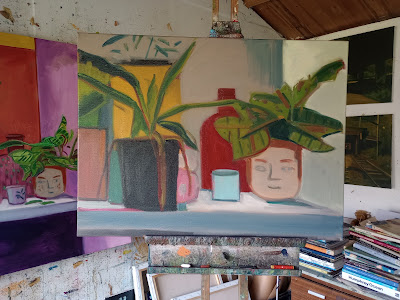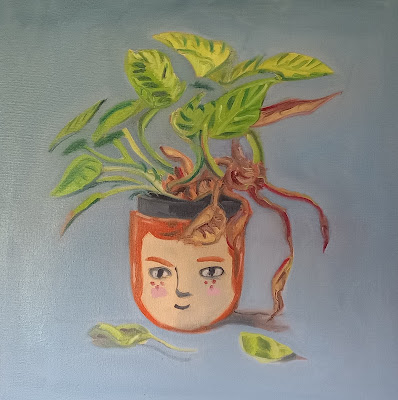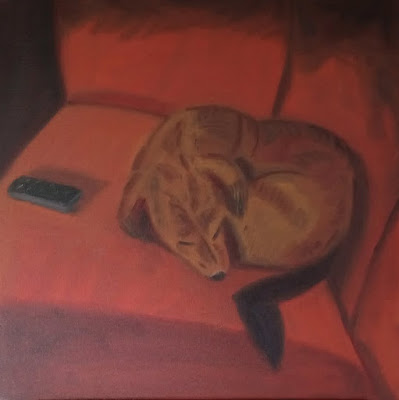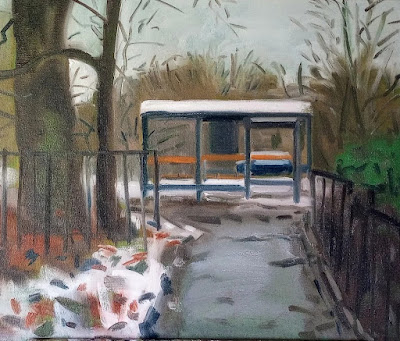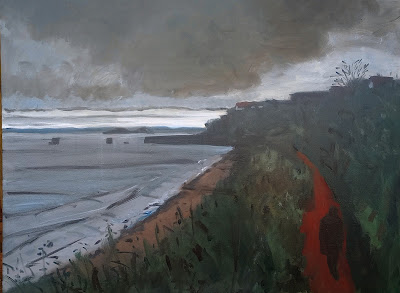Hiding,
oil on canvas, 30 x 40cms, 2025
Since my last blog post the effort spent in trying to resolve the still life painting seemed to kickstart a renewed energy in my painting and in a relatively short time I found myself making a number of new landscape paintings in quick succession, with the still life painting seeming to rapidly disappear from view in the rear-view mirror. It now sits rather mutely on my studio wall, the plant pot with the face staring somewhat annoyed back at me as if it is asking me not to forget it. But painting for me can be like that: I can tend to work quickly from one piece to the next without thinking too much, just doing, just trying to spend some of the energy for painting that I carry internally that can get pent up. This energy tends to then run its course, and one must stop and think and focus again more carefully about what it is I am doing to try and move things on. Which is what has happened with some of these new paintings that I’m quite excited about.
There are these paintings which are the ones that were made fairly quickly, one after the other…
Nomads,
oil on canvas, 60 x 70cms, 2025
Skip,
oil on canvas, 60 x 70cms, 2025
Locking Up,
oil on canvas, 30 x 30cms, 2025
Late Night Truck Stop,
oil on canvas, 50 x 60cms, 2025
View from the Supermarket Rooftop Car Park,
oil on canvas, 50 x 60cms, 2025
Hospital Appointment,
oil on canvas, 50 x 60cms, 2025
And then these larger ones which were more carefully thought out with more preparatory drawing beforehand before being executed…
Night Moves,
oil on canvas, 100 x 120cms
Fable,
oil on canvas, 100 x 150cms, 2025
The Afterlife,
oil on canvas, 90 x 210cms, 2025
Empire of Dirt,
oil on canvas, 100 x 210cms, 2025
These last two very wide canvasses were based on some photographs I took on one of my frequent visits to the local tip during the current bin strike in Birmingham which drags interminably on. I rediscovered these unusually wide (100 x210cms) canvasses from a sort out in the studio and thought they had the potential for some wide compositions that I was excited about that I had developed in my sketchbook. The first painting was based on a view I captured of a sea of discarded white fridges in a corner of the tip that I thought looked so striking. It was the sheer volume of them, but also their repeated sameness that cascaded across the frame with just some colour from the evening light cutting across them as shadows. I immediately saw that these elements correlated with some of the lessons I have absorbed from abstract painting- a lack or compositional hierarchy, a repetition of forms and a limited palette.
The second painting is of a ‘gathering’ of different recycling bins, but this appealed in opposition to the fridges but was equally related to ideas that might be found in more abstract paintings- a rhythmic pattern across the surface created by the varying shapes, sizes and colours of the objects depicted. The planning of these paintings took longer but the actual execution of these paintings took just a couple of hours on each. I find them exciting, and it’s weird that such overlooked, or to some, ugly subject matter can hold such potential. I don’t think the finished paintings look ugly at all.
I’ve enjoyed getting back into the landscape paintings again. There is so much to work with, which can be a blessing but also a curse when it comes to deciding what to work on. There’s too much choice and choices need to be made. But despite this, I’m hoping to work on some further paintings of figures and indoor spaces in the next few weeks..














